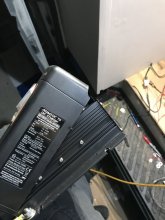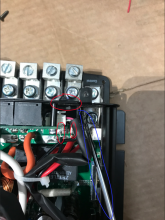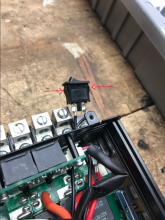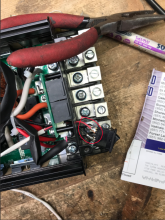Sipma02
New Member
- Joined
- May 27, 2020
- Messages
- 141
I've done a lot of research and thinking of how to set up the best solar/DIY LFP system that I can for our Sprinter install. For reference, we'll have ~400 watts of solar and 280ah of LFP. In my research, I was inspired by @Craig 's method of using the Chargery to shut off his Solar Charge Controller and not even have a relay/DCC that draws power. That said, the SCC that I'm using also accepts alternator input. So sure, I could have wired in a separate port contactor or relay of some sort. But I noticed there is a manual shutoff switch on the bottom of the DMT1250, and it's just a simple on/off switch—two wires.
So I emailed Kisae to see if that was a safe method to shut down the controller. It was totally kosher!

So I carefully took the unit apart. Flip the unit over. I started with these screws:

Then, I removed 2 screws on the back. Unfortunately, you'll have to remove this little sticker (circled in red, probably a warranty thing ). The other screw is the on the opposite side to the screw below:
). The other screw is the on the opposite side to the screw below:

Do not remove the screws on the X's. That was for testing purposes
You should have 4 screws removed.
Gently pry off the cover. A flatblade screwdriver is helpful. You'll have to disconnect a small, simple connector to disconnect the display screen (mounted to the cover) from the rest of the body:

This next part is tough to see. The 2 small red circles are the wires are are going to solder on to. Topmost red circle is the switch itself. The blue circle (oval?) is my screwdriver. I used that to gently pry the switch out:

Now the switch is and about! If you are extremely nimble-fingered and good with a screwdriver, you might be able to get the switch out without disassembling the unit.
If you are bold and handy enough to attempt this, I'm sure you already know to push these tangs in to remove/release the switch:

Now, we solder.

It's not the best solder work I've done, but you can see I've soldered a 18awg wire on the switch leads. The other end of that 18awg wire will go to a small, Normally Open relay. The Chargery HVD will control the relay, and will power the relay to connect the 2 wires. If the Chargery cuts off due to high voltage; it will cut power to the relay, which will turn the unit off and stop charge to by pack. Since this is wired in parallel, the OEM shutoff switch will work normally. That switch will be turned off, so the relay (and therefore Chargery signal) can control the on/off of the DMT1250.
And since this is switching less than .5 amps, you can find the SMALLEST, lowest power draw relay ever!
Reverse the steps to reassemble. Hopefully this helps someone with their system!
So I emailed Kisae to see if that was a safe method to shut down the controller. It was totally kosher!

So I carefully took the unit apart. Flip the unit over. I started with these screws:

Then, I removed 2 screws on the back. Unfortunately, you'll have to remove this little sticker (circled in red, probably a warranty thing

Do not remove the screws on the X's. That was for testing purposes
You should have 4 screws removed.
Gently pry off the cover. A flatblade screwdriver is helpful. You'll have to disconnect a small, simple connector to disconnect the display screen (mounted to the cover) from the rest of the body:

This next part is tough to see. The 2 small red circles are the wires are are going to solder on to. Topmost red circle is the switch itself. The blue circle (oval?) is my screwdriver. I used that to gently pry the switch out:

Now the switch is and about! If you are extremely nimble-fingered and good with a screwdriver, you might be able to get the switch out without disassembling the unit.
If you are bold and handy enough to attempt this, I'm sure you already know to push these tangs in to remove/release the switch:

Now, we solder.

It's not the best solder work I've done, but you can see I've soldered a 18awg wire on the switch leads. The other end of that 18awg wire will go to a small, Normally Open relay. The Chargery HVD will control the relay, and will power the relay to connect the 2 wires. If the Chargery cuts off due to high voltage; it will cut power to the relay, which will turn the unit off and stop charge to by pack. Since this is wired in parallel, the OEM shutoff switch will work normally. That switch will be turned off, so the relay (and therefore Chargery signal) can control the on/off of the DMT1250.
And since this is switching less than .5 amps, you can find the SMALLEST, lowest power draw relay ever!
Reverse the steps to reassemble. Hopefully this helps someone with their system!
Last edited:


